“It is not mere aquisition of knowledge, but a change in being.” J.M.W.Turner
What I respect the most within sumi-e is its nature of contrast, of opposition, the visual – morphological tension that flows during application. It is easy to note the link, inherent link, to the universal and basic symbolism best expressed in the famous Ying-Yang symbol or its versions from other cultures; The Star of David, the Sumerian equal branch cross etc. If we think in that manner, every sumi-e painter is a kind of priest, a magician.
They are shaman-artists who constantly strive to look into the blueprint of creation beyond the visual crowd and the noise of superficial details, the one on task to explore and communicate with a primary game of opposite values during composition and construction of a coherent imagery. They paint from both levels, the personal and the intimate and the universal one which emerges from life-giving tension.
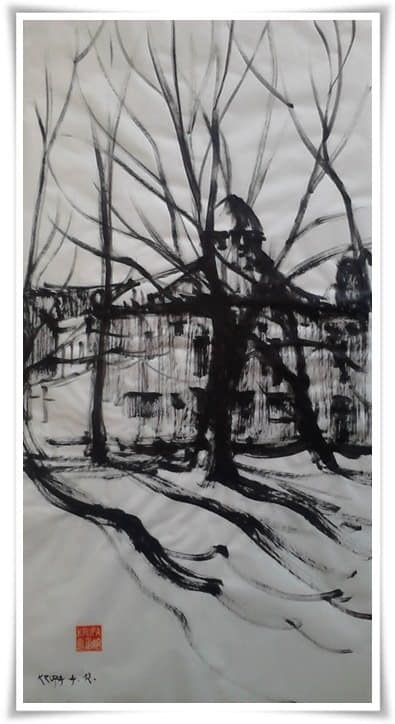
“The Edison Cinema in Karlovac”
69x35cm , ink on Wenzhou rice paper , 2012
“Kino Edison u Karlovcu”
69x35cm, tuš na Wenzhou rižinom papiru, 2012.
Every Ink image, every Sumi-e painting, is a unique crossroad of oppositions, of directions, of intentions. They are all constant reminders of the duality of creation and the accuracy of the equation where two equals one.
And one thing more.
Ink painting is an ancient and genuine East Asian pictorial form, usually associated with the Zen tradition, older than two millenia and originating in the historical “Era of the Warring States”. It is one of the major pictorial forms of the world and is in the realm of the mental concepts of simplification, abstraction and purification. It corresponds to the creative mind of the European Upper Paleolithic muralists of Altamira, Escoural, Niaux, Cougnac, and Lascaux, a mind with the desire to express all and everything with very few strokes, stains and hues. Over here with pigments mixed with fat or blood applied to a cave wall, over there with a solution of pine tree soot utilized in rice/mulberry/bamboo paper.
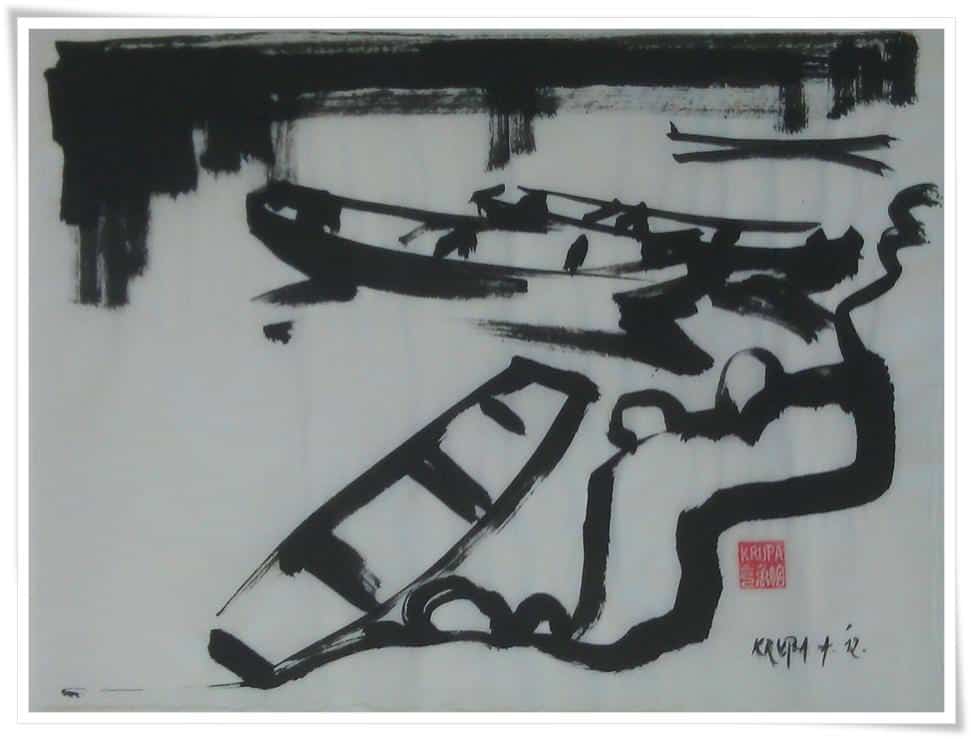
“Boats on Kupa River”
38x48cm , ink on Pi/Kozo (mulberry) paper, 2012
“Čamci na Kupi”
38x48cm, tuš na Pi/Kozo (dudovom) papiru, 2012.
The study of ink painting for me began in the late 80’s with a former student of the famous Polish painter and member of the “Young Poland” movement, Prof. Jozef Mehoffer (1869-1946), my Grandfather and renowned Croatian-Yugoslavian watercolor painter and draftsman Prof. Alfred Krupa (Alfred Joseph Krūppa , 1915-1989, born Mikolow, Poland, died Karlovac, Croatia.)
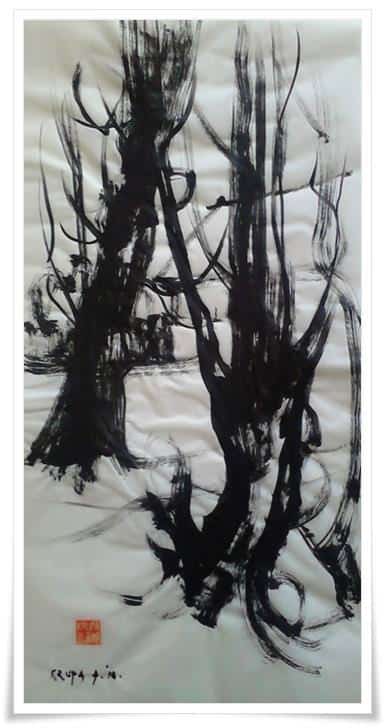
“Old poplars”
69x35cm, ink on Wenzhou rice paper, 2012
“Stari jablanovi”
69x35cm, tuš na Wenzhou rižinom papiru, 2012.
At the Academy of Fine Arts (University of Zagreb), I studied with Professors Josip Biffel, Nikola Koydl, Vasilije Jordan and Zlatko Kauzlaric and graduated in 1995, presenting an exhibition of en plein air watercolors. From 1998-1999, I studied with Prof. Akira Itoh at the Research Institute of Fine Arts at Tokyo Gakugei University, as the first Croatian painter-recipient of a Japanese Government Scholarship. My pedagogical work started in 1993, but since 2004, I have been teaching fine arts, a group of courses at the Secondary School Duga Resa in the graphic design department. In 2013 it will have been 20 years since I was given my first scroll of rice paper and an ink stick from my university professor Zlata Meštrović at the Academy of Fine Arts in Zagreb.
One of my primary goals in my own artistic expression is to avoid the abyss of being “cute”, “tasty”, “nice” and any other deeply rooted formalism (particularly in stereotypical motives/composition and superficial “spirituality”). On other hand, I am trying to reach direct, spontaneous, raw expression, with a heavy emphasis on personal and authentic artistic handwriting. Some people are focused on, or even obsessed with the “beauty” of line and its graciosity. And that is a legitimate intention and a necessary one in calligraphic writing, but it is not my path. At the end of the day, I will produce my own shape, my own drawing texture and my own morphology of a line. I do not care if it is “ugly”, almost always a subjective description, or “imperfect”, or not in keeping with a traditional view and a consideration of “craftmanship”. It must be a genuine and direct materialisation and footprint of my mind’s flow and structure along with my feeling. And when such an “event” occurs, by default, it inherently contains clarity and artistic honesty. With this approach, I believe that I will create original art, original at its very root, my own artistic grammar.
The above is one of the reasons I use mainly ink and watercolor. It does not allow me corrections and second thoughts. In my teaching, I constantly suggest to my pupils, in an effort to avoid scribble and smudge, to gain substantial drawing experience, first in dry techniques like pencil, chalk, chacoal, and pastel, and to master perspective, composition, proportion and all other basic elements in front of a real life model/motif still-life before they begin with Ink. My own work reveals me, who I am without a mask, non-verbal communication, a paradise for the trained eye of a psychologist.

“Old boat on Korana River”
38x48cm , ink on Pi/Kozo (mulberry) paper, 2012
“Stari čamac na Korani”
38x48cm, tuš na Pi/Kozo (dudovom) papiru, 2012.
In my watercolors I always try to be transparent, fluid, something hardwired in me by family tradition. Watercolor is poetic, ultimately subtle and fresh in its nature. That is what I am seeking in that particular medium. But, when it comes to my Chinese Inks, I do not dilute full black with water because water means shades, and that means options. I do not want to have options. I want to create legitimate personal raw expression in a situation with minimum technical possibilities. An achievement in circumstances of objective difficulties/limitations contains additional value.
This is not a new approach and certainly is not my own invention. Long ago it was named Hakubyou 白描 or Hakuga 白画 or “White drawing”. As a finished work, hakubyou rejects color, believed to inhibit the freedom of brushlines.
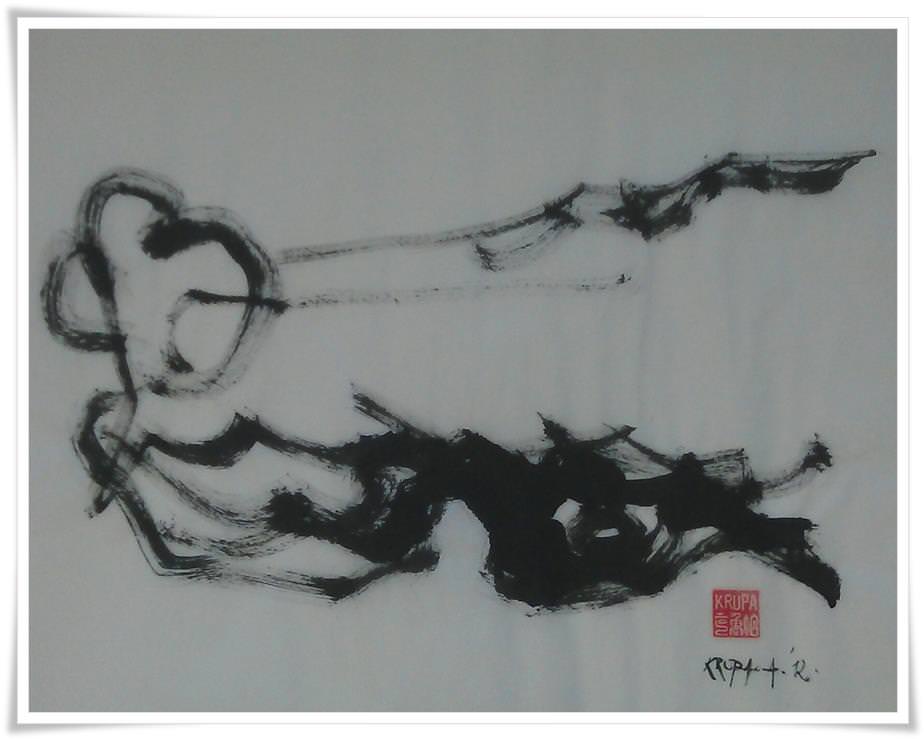
“A small tree, the coast and the sea”
38x48cm , ink on Pi/Kozo (mulberry) paper, 2012
“Malo drvo,obala i uzburkano more”
38x48cm, tuš na Pi/Kozo (dudovom) papiru, 2012.
Motifs. I adore nature. Thus, landscapes in general and trees and rivers in particular are the most chosen compositions of my work. But, as is self-evident, those landscapes do not resemble Chinese or Japanese scenery morphology, often imitated by Western artists. Since I am born in Europe, I am, by that definition, Western. Different energies are imprinted in my genes. Any copying of once original artistic forms by famous East Asian painter-legends are not an option for me (except for the purpose of study/learning). I would consider myself to be a liar to say otherwise.
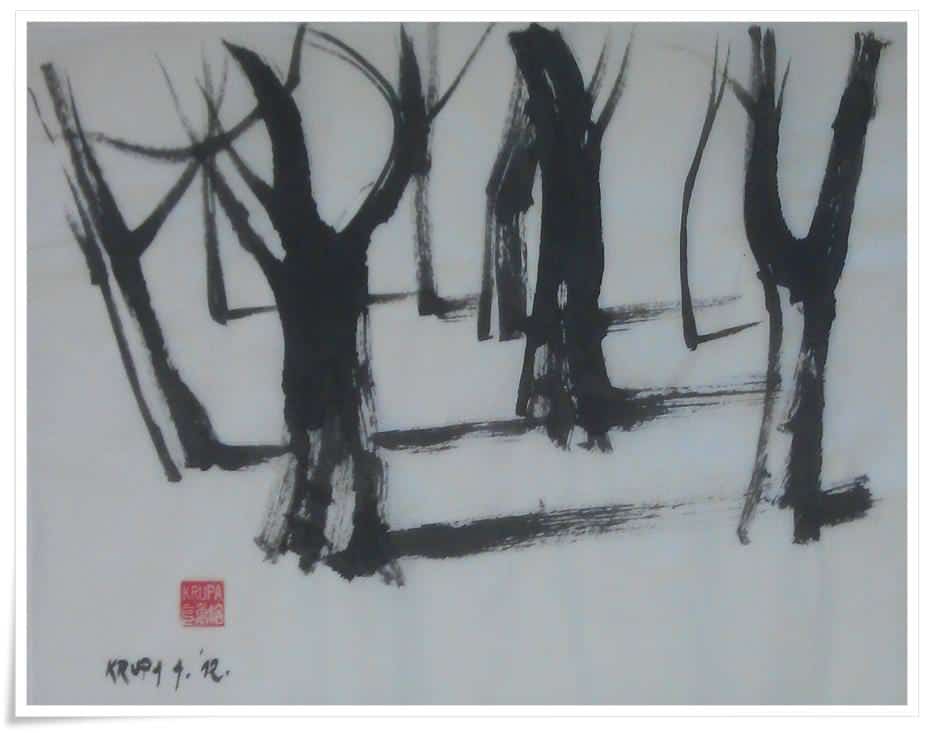
“Queue chestnuts”
38x48cm , ink on Pi/Kozo (mulberry) paper, 2012
“Peterored kestenova”
38x48cm, tuš na Pi/Kozo (dudovom) papiru, 2012.
The several months study as a postgraduate research student at Tokyo Gakugei University (東京学芸大学) or Gakudai (学大) in 1998 and 1999, particularly the journey to the Hakone National Park (Fuji-Hakone-Izu Kokuritsu Kōen) near Fuji-San on an old route from Tokyo to Kyoto (including a visit to lake Ashinoko, sulfuric water springs, Hakone Shinto Shrine/Hakone Jinja etc.) showed to me the contrast between the scenery of Japan and where I live, in central Croatia, including a specific taste and smell of space and place. It is true that I still treasure that experience in my heart and mind. And not just that, it was an experience which could be described as a permanent transformatory one. My work has been changed forever, but I still remain a European artist.
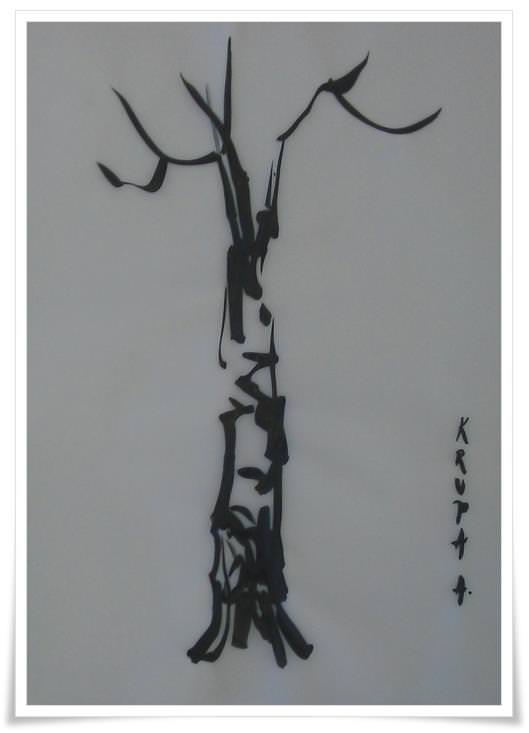
“Birch (tree)”
40x29cm, ink on tracing paper, 2012.
“Breza”
40x29cm, tuš na paus papiru, 2012.
In deciding which materials to choose, I am completely unorthodox. I work with and on everything within my grasp; all kinds of ink sticks or already prepared liquid ink, rice-mulberry paper, cotton paper, bamboo paper, watercolor rug paper, cardboard, among many. I work from time to time even on canvas prepared for oil painting and in combination with other techniques (multi-media).
To traditional brushes made of Bear Hair, Wolf Hair/Weasel Hair, Horse Mane or blue siberian squirrel hair, I add sticks made from wood, bamboo pens, plastic feathers with a built-in ink bottle cap, etc.
With our historical/artistic and social experience, in my humble opinion, everything is suitable to express the creative genius of a contemporary artist.
To learn more about Professor Alfred Freddy Krupa (Krūppa), please see his website
